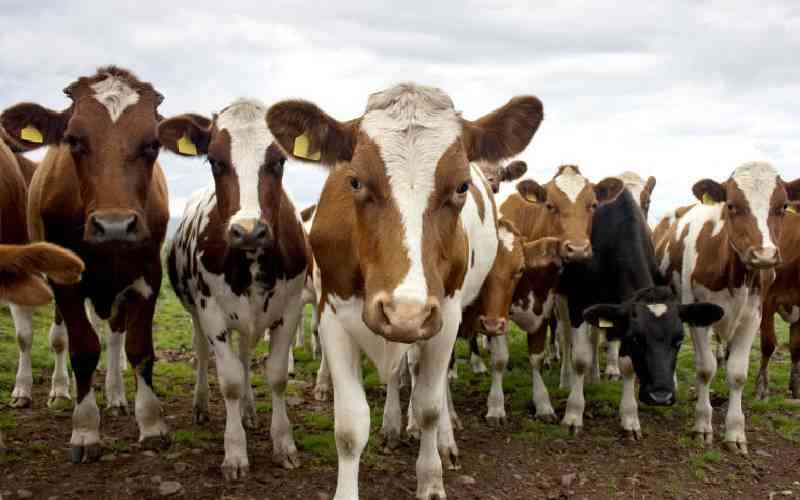Recently a cow in Bungoma County made news by breaking into a busaa brewing den taking one too many. It got drunk and unable to move from her “bar” without the intervention of a veterinary doctor. Many myths followed the otherwise common incident in veterinary spheres.
Animals don’t steal; they can never be called thieves because thieves plan using their brains how and when to commit an offence for selfish gains. On the other hand, animals are directed by survival instincts to do whatever they do and it is never selfish. Cereal or concentrate stores are among their favourite places where they can collectively or individually launch a break-in to satiate their cravings which at times can turn deadly.
Such break-ins are common after the harvesting season; they will instinctively crave for grains after the monotonous feeding on maize stovers or straws and should an opportunity avail itself they will not waste the chance.
Stomach pain
Accidental excessive feeding on grains especially maize, wheat or barley in cattle, sheep and goats will result in a condition called grain overload, acidosis or grain poisoning. Grain overload is an acute condition that can easily cause death if no medical intervention is taken.
While the condition is called grain overload it normally follows an accidental exposure to large quantities of easily digestible and fermentable carbohydrates that animals haven’t been accustomed to.
In most cases, cereals are involved but others like bread and sweet potatoes can also cause grain overdose. Ground or pelleted grains are more fatal than whole grains because they are easily digested. Exposure can also happen when animals are grazed in newly harvested paddocks with unharvested grains or grain spills.
The severity of the condition depends on the type of feed ingested, the nutritional condition of the animal and rate of exposure to such diets.
As little as 10kgs and as much as 20kgs of readily digestible carbohydrate feed will result in grain overload depending on the above mentioned reasons. Upon ingestion; such feeds will within two to five hours alter the rumen environment by favouring a population explosion of bacteria that produce lots of lactic acid.
The acid produced doesn’t only kill other rumen micro-organisms but also causes an influx of fluid back into the rumen and prevents rumen motility which is crucial for digestion of lots of fibre in ruminant feed.
Thus the first sign a farmer sees in an animal with grain overload is a sudden disappearance in ruminal movement as the rumen is distended and the animal will show some discomfort arising from abdominal pain.
This pain will make the animal to kick its belly or to trend on its hind legs. Other clinical signs of grain overload will depend on the severity of the condition. The mild form of disease will be shown by loss of appetite and diarrhoea but the animal will remain alert and will recover after about four days even without medical intervention. Animals with a severe form of the condition will stagger or fall down and can remain in recumbent position and will not eat anything including water but will diarrhoea.
The watery dung will have sweet-sour smell and will be soft and yellowish brown in colour. A closer observation of the feaces will reveal partly digested particles of the causative grains. While the body temperature will fall the heart rate will increase.
When you palpate the ruminant on the left side just behind the last rib you will doughy rumen content and gurgling sound of gases passing through fluid. Severely affected animals will not see clearly and will at times bump into objects.
Call a vet
If veterinary interventions are not timely executed; an animal with severe grain overload may die within two to three days. Grain overdose should be suspected whenever a single animal or a herd of animals suddenly stagger or fall down and are unable to rise up after being out on their own.
Stay informed. Subscribe to our newsletter
If you have a grain store on your farm check for any signs of destruction. The fortunate thing about this condition is that it is relatively easily to manage but high mortalities are normally recorded due to delay in medical intervention.
Restricting water intake in animals suspected to have eaten large quantities of grains has been shown to lower the severity of the disease maybe by lowering the fermentation process.
In affected animals that are still standing the medical intervention will involve removal of the culprit rumen content and replacement with rumen content from a healthy animal (they are plentiful in slaughter houses).
Normally a surgical incision into the rumen is preferred although rumen content can still be aspirated through a tube.
The animal will then be put in fluid therapy for the next one day to normalise the body system. If grain overdose happens in beef animals herd that are about to be slaughtered, then they can be slaughtered instead of going through the treatment process as this will save costs.
Grain overload can be prevented through gradual introduction of animals to grains.
Sometimes farmers are tempted to introduce a lot of grains to animals for example during lactation or weaning to attain a certain weight gain.
Consult your vet to direct you on precautions to take in such instances. When introducing grains ensure the animal diet has enough roughages for example good quality hay or silage during this time and keenly observe your animals for any signs of grain overload and quickly call your vet to intervene.
-The writer is a veterinary surgeon working as a Communication Officer for the Kenya Tsetse and Trypanosomiasis Eradication Council - KENTTEC
 The Standard Group Plc is a
multi-media organization with investments in media platforms spanning newspaper
print operations, television, radio broadcasting, digital and online services. The
Standard Group is recognized as a leading multi-media house in Kenya with a key
influence in matters of national and international interest.
The Standard Group Plc is a
multi-media organization with investments in media platforms spanning newspaper
print operations, television, radio broadcasting, digital and online services. The
Standard Group is recognized as a leading multi-media house in Kenya with a key
influence in matters of national and international interest.
 The Standard Group Plc is a
multi-media organization with investments in media platforms spanning newspaper
print operations, television, radio broadcasting, digital and online services. The
Standard Group is recognized as a leading multi-media house in Kenya with a key
influence in matters of national and international interest.
The Standard Group Plc is a
multi-media organization with investments in media platforms spanning newspaper
print operations, television, radio broadcasting, digital and online services. The
Standard Group is recognized as a leading multi-media house in Kenya with a key
influence in matters of national and international interest.







